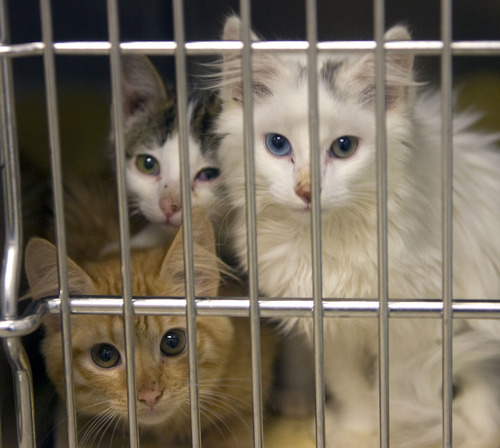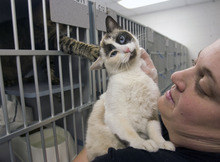This is an archived article that was published on sltrib.com in 2011, and information in the article may be outdated. It is provided only for personal research purposes and may not be reprinted.
Millcreek • Salt Lake County's animal shelter is on the verge of becoming a no-kill haven, with more adoptions and fewer deaths in 2010 than ever.
In fact, not a single adoptable dog or cat was put down last year.
The shelter's record-breaking year reflects a radical change of culture within the county's animal division, where kill rates were so high a decade ago that a third of all dogs and 81 percent of cats never made it out of the shelter alive.
That's not the case any longer. The change is no more evident than in Director Shawni Larrabee's reluctance to use an achingly familiar word in the animal-control business: euthanasia. She chooses a more chilling vocabulary that includes terms such as "killing" and "dying."
It's not that Larrabee is a zealot — until three years ago, her background was in banking — but she sees the term "euthanasia" as too genteel for a practice she considers inappropriate for controlling pet counts.
"The reality is they are dying here," she says. "It is not OK to use euthanasia as a population-management control. It is not. We view euthanasia as a last resort and as a failure of programs to serve the pet population that we serve."
That philosophy has helped transform the county's handling of pets, leading animal services to increase adoptions and decrease deaths by the hundreds — even as Utah's most populous county has suffered an economic downturn that left the shelter, at 511 W. 3900 South, with less money and more abandoned animals.
"They have met and exceeded my expectations," says second-term Mayor Peter Corroon, who made increased pet adoptions a campaign pledge. "It has been amazing to see the changes that have been made."
In a shelter that hasn't killed a single animal because of overcrowding in more than a year, Larrabee says the county turns to euthanasia — she hesitates on that word — only when an animal is seriously ill or dangerous. If the critter can be nursed back to health or adopted, it stays.
Consequently, the county is killing far fewer animals than ever. The numbers are staggering.
The shelter in Millcreek euthanized 481 dogs last year. That compares with 1,048 killed during an average year between 2001 and 2009. The shelter also euthanized 1,419 cats. That compares with 3,212 put to sleep during an average year.
None of the pets euthanized during 2010 was considered "adoptable."
As deaths have dropped, adoptions have gone up. The shelter found homes for 1,217 dogs and 1,623 cats last year, compared with an annual average 984 dogs and 653 cats during the previous decade.
"Salt Lake County is the leader in Utah," says Kalinda Solbes, interim executive director of the nonprofit No More Homeless Pets in Utah. "They are really doing a fabulous job."
The next milestone for the county's pet patrol could be becoming a no-kill shelter.
"We are almost there now," Larrabee says.
No More Homeless Pets defines no-kill as a shelter that euthanizes no more than five animals for every 1,000 people the shelter serves. The county now is at 5.3.
"There is a contingent out there who says it is not our fault, that it is a community problem," Larrabee says, citing a euthanasia rate of 13.4 throughout the rest of the state. "I'm sorry, but if we could do this during the last two budget years, and reallocate resources when we were in the middle of budget cuts, then anybody can start doing something."
The shelter's efforts have earned acknowledgment inside Utah and out. The county placed fifth in a nationwide adoption blitz by the American Society for the Prevention of Cruelty to Animals. During the three-month contest period, the county found homes for 1,000 animals.
"They are coming up with innovative ways to get [pets] into homes and out of the shelter," says Emily Weiss, the society's senior director of shelter research and development. "That is what it is all about."
Meanwhile, the Humane Society of Utah is seeing a similar upward trend in adoptions. The shelter, according to The Associated Press, released 4,000 dogs and 3,200 cats to homes in 2010, an increase of about 4 percent. Like Salt Lake County, it didn't euthanize a single "adoptable" dog or cat last year.
So why has the county's success been so dramatic? (Dog adoptions up 10.7 percent and deaths down 7.5 percent from 2009; cat adoptions up 14.3 percent and deaths down 18.8 percent.)
Free felines, for one thing. The county has done away with its $65 adoption fee for adult cats. Kittens still cost, but cats 6 months and older get a free pass to a new home.
Dogs, on the other hand, are sold on a sliding scale from no cost to $295. While the shelter used to sell those pets for a flat $95 fee, it now is using the extra money to subsidize its cat program.
But free cats are only part of the story — albeit a big part.
The county has enlisted the help of a volunteer "Pit Crew" to find homes for sometimes-tough-to-adopt pit bulls. It has partnered with No More Homeless Pets to trap, neuter and release feral cats that otherwise would be euthanized. The shelter has doubled up, and tripled up, animals in pens to increase its holding capacity.
But none of those will fix the county's pet problem, Larrabee says. The only real solution: responsible pet owners. Owners who spay and neuter their pets. Owners who pay attention to their pets. Owners who keep their pets for life.
"The community needs to wake up and realize that it doesn't have to be this way."





